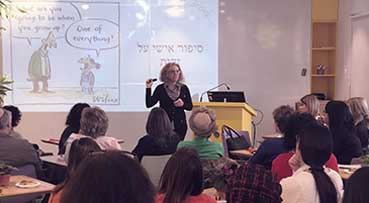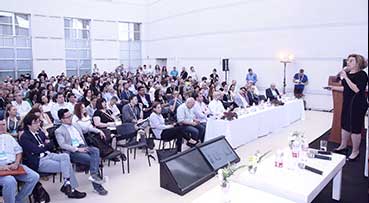Leaders create futures. If you’re a leader, you are used to painting the picture of the future for the organization, and you know that organization will shift and change to get there. But once in a while something in this pattern breaks down and the “how” the organization moves towards that future will not get you to where you want to go. It’s not enough to focus on innovation of your technology, products and services. Once in a while we discover we need to rethink our paradigms for the organizations, for how work gets done, for how we manage it, organize it, staff for it. When that time arrives, it is no longer enough to fix and adjust, it is time to create a new future for the “how” of the organization, one that is not bound by the rules of the past.
Remember Henry Ford? Yes, the cars. Yet on his Wikipedia page, in the very first sentence he is described as “the founder of the Ford Motor Company, and the sponsor of the development of the assembly line technique of mass production.” History remembers Ford for the assembly line and mass production, not for giving us the Model T. Think about it. Ford had a vision, a car for the middle class. He already had a motor company. He could have focused on innovation around the car, the engine, the design. He could have hired more people to work for a dollar a day and do what they already did, just a little faster, better, more efficient. But no, Ford understood that you can’t make cars for the middle class doing the same, just a little faster. He understood that to bring his vision to life he needed to look backwards, into his factory, and do something different. Something that will generate those cars at a rate and cost that would allow his workers to buy them. This is an important lesson, the ability to identify those times when vision requires the organization behind you to re-arrange itself in new ways, to do something completely different, not the same a little faster…
You can already see signs that organizational structures are shifting, the old moving on and something new asking to emerge. Around the world we see more and more examples for new ways of work coming together to address the limitations of the hierarchical organizational structures most of us work in. Many leaders begin to see that what got them here won’t take them into the future they are trying to create. That they need a new range of possibilities for organizational processes to arrive at that future. In many cases, this realization shows up in the form of one of the biggest bottle necks in the organization, that of decision making rising up to the top, to that one layer where the full picture is observed. To understand why this is happening, it is important to understand how the hierarchical organization came into being, and why it is now reaching its limits.
If we examine the history of organizations, hierarchies were born in those places where a system was required to ensure a large number of people knew what to do. Hierarchy is based on the principle that at the top are those who have the power. Initially, that was power and not knowledge. Power, which in many cases came from who you were born to be and not what you know or can do. Think about the church or ancient armies, led by nobility. Down the hierarchy were those people whose role it was to take that power and turn them into action. And the people at the bottom, they were simply there to execute, hands, bodies.
Liberation for those who were not born into power came when knowledge was added into the mix. When it was no longer enough to be born to be a leader, you had to be the most capable or knowledgeable person in the field. And this is where we get back to Ford, who understood something others did not, and was visionary enough to create a system around that to execute. The role of managers in this new era was to ensure the smooth operation of the organizational machine, so that it executes at its best. Managers provided the knowledge, employees were working hands. And so we managed to build long term processes, take care of more and more complexity and develop whole industries and complete new worlds of products and services.
But speed of change increased and more and more organizations realized that the faster they could respond, the more profitable they will become. For quite some time organizations have been trying to develop to become more agile. Innovation appeared in the form of R&D organizations and with them came workers’ responsibility for the work. In the knowledge industry, manager roles shifted, no longer telling employees what to do. Instead, they set out targets but left it up to the brains working for them to define how to get to those targets. In this era of knowledge work, employees were no longer replaceable hands in the well-oiled production line. This organizational world brought with it terms such as MBOs, performance management and meritocracy, culture, values and empowerment. We also realized that the role of the manager can no longer be simply to manage the tasks, and so we asked them to manage the people.
The organizational structure, though still hierarchical, evolved to include more matrix management, where employees had more than one manager. In such structures, employees had at least two reference points, for example managers determined geographically (a local manager), organizationally (a business unit manager) or by function, by project etc. But with the increase in pace of change, and with it the need to stay agile, respond quickly, enable free movement of information up and down the organization, as well as sideways, the matrix organization could not solve all the facets of flexibility required. In the last few years we are discovering that the organization cannot accomplish its strategy when each one of its units works in relative autonomy. The increasing complexity drove us to create horizontal processes, to create roles that bridge between the units. And this is where we run into the limitations of the organizational hierarchy, which pushes the complexity up the organization so that the full picture emerges only at the top, and with it the only place having what it takes it made decisions. Hence the bottleneck.
We already know that knowledge is no longer the proprietary of those at the top. Moreover, we recognize the huge power that lies in the knowledge of the crowd, certainly the crowd within the organization. I recently heard a story from a young medical doctor, a surgical resident. She was observing repeated situations in the OR, where an entire team is on hold due to faulty tools, requiring a nurse to leave the OR and bring a replacement tool from a different OR. This is a simple tool, its cost much less than that of the wait of a full OR team, let alone the risk to the patient on the table. But the hospital management, trying to cut cost, is not utilizing the knowledge of its people to identify where the low hanging fruit is available.
This is not a unique example, they probably exist in your world as well. Think about yourselves as customers. Maybe you too find yourself wondering about the waste of paper coupons we receive and immediately throw away at the cash register, or the credit card envelopes arriving one by one from the same card company instead of putting all of them into one envelope. As customers, workers, we see those places where the organization is inefficient, where processes, decisions, products, services can be made better. But as managers, are you talking to those who know where to find them?
A few years ago I was working with the organization on an impossible workload for a group of experts, who had become a bottleneck in a process. The experts were complaining, waiting for their managers to solve their problem. Their managers were complaining to their managers, all the way up the chain, where senior managers simply told them this is the new normal and we simply need to work “a little faster”. Remember Ford? Can’t make a car for the masses by doing the same work faster…
So we tried something new, something to break the pattern where each layer complained and expected the layer above them to solve the problem. We led the organization through an innovative crowd conversation process. Using a simple tool adapted from ideation, we asked that same group of experts, without limiting their scope for response in any way, what would they want addressed to deal with the workload? Hundreds of ideas were generated in a week, discussed by the crowd and created a significant change in the work environment. Since then the organization has been using this tool in multiple situations to ensure the knowledge residing within the organization gets to where the decisions can be made. And many decisions are made on the spot, within the crowd discussion.
So what next? The fact that hierarchy is reaching its limits does not translate to an organization with no structure. We already see attempts at organizing work without the need for hierarchy. An interesting example is Valve, a video gaming company employing hundreds of people, all of whom are listed on the company website. If you or your younger generation play video games, you might be familiar with their platform, Steam. According to Forbes, the company is positioned in the video games market right after Nintendo, Microsoft and Sony and makes more per employee than Google or Apple. And on decision making, in their Handbook for New Employees Valve welcomes their new employees “to Flatland”, intended to remove any barriers between its workers and the customers. They took the phrase “the customer is king” to the edge and the organization expects its employees to understand what the customer wants and give it to them. The desks have wheels and employees move them next to those they choose to work with on a given project. So who decides? The employee, who is told to select what they work on according to where they bring most value. They have the power to make decisions, but are encouraged to listen, expand the conversation and perspective not because they need approval, but due to the value of feedback, experience, diverse perspectives and information. And then decide according to what is right for the customer. And structure? Structure can arise on a given project as people take on leadership roles because of their behavior and knowledge, not because of an assigned role. Temporarily, and as long as it brings value.
There is no recipe for an alternative organizational structure. But it is certainly time to ask questions about the limitations of the one we live in and its ability to support the strategy. The ability of existing processes to take you towards the vision of the future. Or maybe, like Ford, it is time for you to turn your eyes back into the organization, the talent, the processes, and check whether that is where you need to innovate.
Because the future of work is coming, whether we like it or not. It’s not a matter of if, only when, and will you be ready?

![large-AX1A2125-2[1] large-AX1A2125-2[1]](https://niritcohen.com/wp-content/uploads/elementor/thumbs/large-AX1A2125-21-pnzedcs72atx5aeurqytqdiihxixlq02re9mlz805s.jpg)






